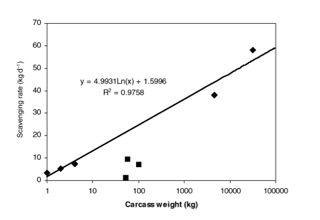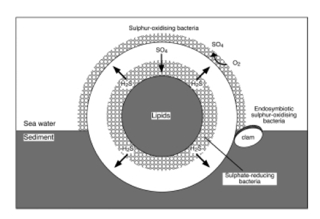Whale Funeral: Underwater Decomposition of Large Carcasses
by Emily Rose Nelson,
RJD Intern
Like any living thing, the lives of whales must come to an end at some point. Upon the death of these massive creatures some may strand and end up on shore, others may float and quickly be removed by other animals, and at least 50 percent will sink to the bottom of the seafloor. Whale carcasses reaching the depths of the ocean support high diversity by providing immense quantities of organic matter, a phenomenon known as a whale fall. The cold deep water acts as a refrigerator and slows decomposition significantly. Under these circumstances whales have the ability to live on after their death for over 50 years supporting entire communities in the deep sea.
Whale falls consist of up to four successional stages, each involving changes in species composition, mobility, and overall trophic structure. The first stage in this process is known as the mobile-scavenger stage. Starting anywhere from 0.5-1.5 months after the carcass initially hits the seafloor animals congregate to feast on the whales soft tissues. Sleeper sharks, ranging in size from 1.5m to 3.5m, are the first to arrive and remove more tissue than any other species. They are followed by hundreds of hagfish, coming from areas of 1-2 km2. As the remaining tissue fragments diminish in size they are consumed by successively smaller scavengers. Rattail fish, followed by amphipods, and finally copepods remove what tissue is left. The mobile-scavenger stage draws to a close when all of the soft tissue has been removed from the carcass, (nearly 90 percent of the whale’s wet weight) which can take anywhere from 4 months to 5 years depending on body size.

The duration of the mobile scavenger stage is a function of the carcass size, which can be seen in this linear representation. Baco and Smith.
Upon completion of the mobile-scavenger stage the bones and surrounding organic rich sediments are colonized by large numbers of bottom dwellers, starting the enrichment opportunity stage. Free-living polychaete worms, gastropods, juvenile bivalves, some crustaceans, and more have been reported in dense populations in and around whale bones. These species are dominant in the whale-enriched sediments but have not been collected in surrounding communities. The highest ever macrobenthos (visible organisms living at the bottom of the water column) densities below 1000m were recorded within 1m of a skeleton. Despite such high density, species diversity was drastically reduced in the same area. These findings, combined with the absence of dominant species in surrounding communities, suggest rapid recruitment and population growth during the enrichment opportunity stage. It is difficult to determine the length of this stage; it is believed to be less than 2 years but varies with carcass size.
The sulphophilic stage is the most diverse of all, and the most diverse of all hard substrates in the deep sea. It is in this stage that a large, trophically complex, community thrives on the skeleton. Whale skeleton decay is now dominated by bacterial decomposition of lipid reserves from within the bones. This process releases sulfides, allowing species capable of chemoautotrophy (getting their food from inorganic chemicals) to thrive. Bacterial grazers, bone lipid consumers, predators, and other organisms tolerant of high sulfide levels also occupy the skeleton. This is a long lasting stage, ranging from at least 15 to over 50 years.

Cross section of a whale vertebra is shown. As lipids decompose sulfides are released. Baco and Smith
Because of the long length of the sulpophilic stage there is no evidence of the final, reef stage, yet. This stage occurs after all organic material has been removed from the whale and the only thing remaining is minerals from the skeleton. It is believed to be dominated by suspension feeders, using the skeleton as an aid in water flow. On small skeletons the bones may decompose before this stage can be reached, and with large skeletons it can take many decades to reach this stage.
21 species identified exclusively on whale remains have been deemed whale fall specialists. It is believed these animals have been utilizing this unique habitat for tens of millions of years, and have evolved to make the most of the sulfide rich habitat produced in the sulphophilic stage. They are found in high abundance showing they are well adapted to the whale fall habitat and can easily attain large population sizes. This group is also taxonomic and functionally diverse, representing 5 different phyla. This indicates a wide variety of organisms specifically adapted to survive in whale falls.
Video:
Whale Fall (after life of a whale) [Radiolab] from Sharon Shattuck on Vimeo.
REFERENCES
Smith, Craig R., and Amy R. Baco. “Ecology of Whale Falls at the Deep-Sea Floor.” Oceanography and Marine Biology: An Annual Review (2003): 311-54.
Baco, Ar, and Cr Smith. “High Species Richness in Deep-sea Chemoautotrophic Whale Skeleton Communities.” Marine Ecology Progress Series 260 (2003): 109-14.




Well done! Whale fall partly sustains the Greenland shark population in the St. Lawrence Estuary.